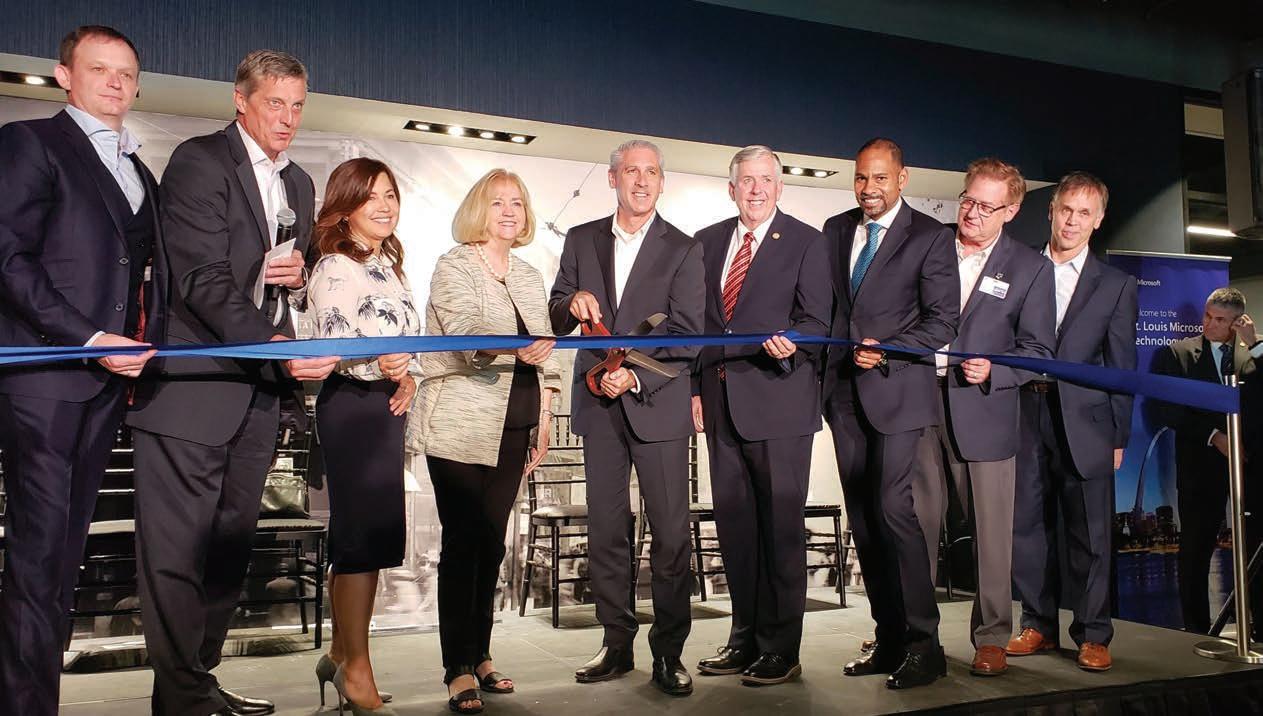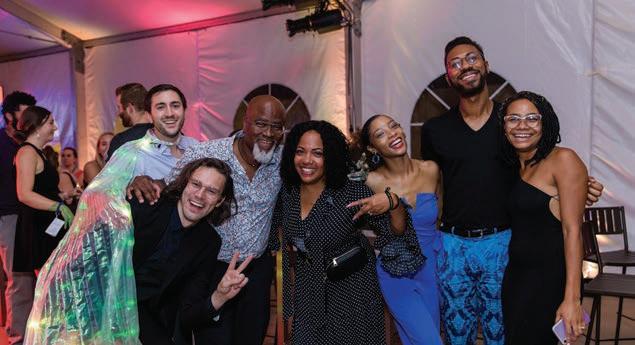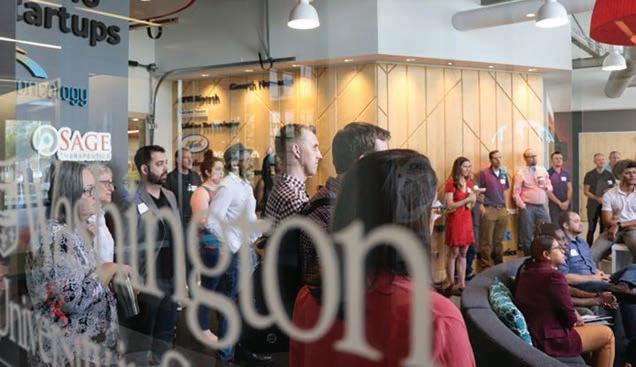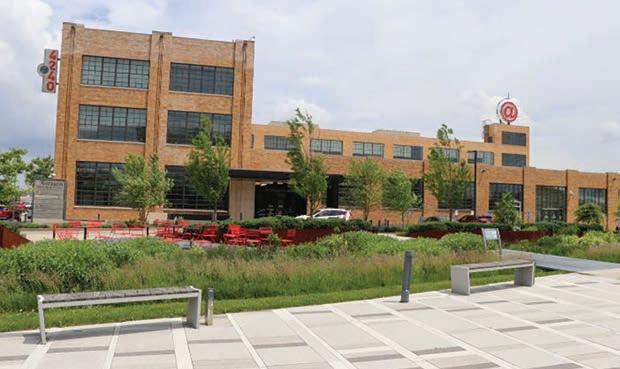
8 minute read
CORTEX: WHY YOU BELONG HERE
Written By Craig Kaminer
As part of my writing about important innovation initiatives in St. Louis, I recently sat down with Sam Fiorello to talk about his new role as president and CEO of Cortex. Sam was raised in Madison, Wis., and he and his wife Rebecca lived in Chicago, Austin, Tex., Rome, London, and Washington, D.C. before moving to St. Louis 25 years ago. “St. Louis was never on the radar screen for me. We moved here because Rebecca got a job at Washington University while we were working in D.C. I was doing work with The World Bank and putting together public-private partnerships. So we moved to St. Louis and now it’s where I’m from. It’s who I am.”
Sam was originally hired by Monsanto where he spent time doing international public-private partnerships in Brazil, India, Indonesia, and other parts of Southeast Asia. One of his mentors, Hendrik Verfaillie, was elevated to president and CEO. He asked Sam if he would be his chief of staff. “I said, sure, but shortly thereafter, Dr. Danforth approached Monsanto with this audacious idea to start the world’s premier plant and ag research institute.” According to Sam, the new institute would be funded in a way to attract top-quality scientists and have an affiliated innovation park where companies could go from discovery all the way to commercialization. “I was asked by the Monsanto CEO to see if it made sense for Monsanto to be involved. I visited seven independent research institutes around the country to find out what worked, what didn’t work, and what would they have done differently.”

MICROSOFT ribbon-cutting ceremony in 2018.
Soon after, Sam put together a business plan and presented it in July 1997 to a fledgling board composed of Dr. Danforth, Mark Wrighton of Washington University, Peter Raven of the Missouri Botanical Garden, Hendrik Verfaillie of Monsanto, and Chancellor of the University of Missouri Richard Wallace. “To move it forward, we needed a commitment of funding. And the number that I put down for a ‘go/no go’ ticket to get into the game was $100 million. In December of that year, I pitched the idea to Monsanto and the Monsanto Fund. They pledged $50 million and said, ‘you know, it’s a match kind of thing and you’ve got 90 days to match it or it goes away.’ In January, we presented to the Danforth Foundation and they pledged another $60 million.”
“So, we were off and running. We had the money that we needed. I was asked by Dr. Danforth to consider leaving Monsanto to help start this and I did. It was terrific. We borrowed offices at WashU’s West Campus at the old Famous-Barr building and we recruited a scientist named Roger Beachy to be the president. We started hiring faculty and designing the buildings. It was great. But from the very beginning, we knew it would not be enough to be a terrific place of discovery with a purely academic model. We had a culture and a mindset to improve the human condition through plant science.”
Fast forward 22 years to August 2019 when the search started for a new president and CEO of Cortex. “A couple of Cortex board members approached me saying, ‘you should put your hat in the ring. I think you’d be a great candidate.’ I said no, I’ve got a really great thing here. And then my wife and I were talking and I said, ‘I’m 57, I’ve got it really good, I probably have 10 to 15 years of hard-driving work left. Where can I make a bigger difference?’ And ironically for the Danforth Center, the answer is making a difference globally. But for Cortex, I thought I could make a bigger impact on the city and the region. It’s creating more jobs here and the whole diversity, equity, and inclusion piece. We’re in an urban center.” Lucky for us, Sam wanted to make a bigger impact in St. Louis.

Sam is a first-generation American. His parents were born and raised in a poor part of Sicily. They moved to the United States in 1960 and Sam was born in 1963. He was the first kid in the family to not only go to college but to high school. “I have always had this real appreciation for the opportunity America provided us. Our lives were better as my parents worked hard. They gave us access to a great education and we went to public schools in Madison. And then, I went to undergrad at the University of Wisconsin. I’ve always had an entrepreneurial zeal. I really enjoy working with innovators and entrepreneurs who are looking at the pain points in the world and how we can solve them.”
"Those skills were perfectly suited for the Danforth Plant Science Center and now for Cortex. Cortex is a shiny star in a constellation of other stars. We’re not alone. And it’s incumbent on us to find partnership opportunities wherever we can. Sometimes as the lead partner in an endeavor and sometimes in a supporting role. Are there any glaring gaps that need to be filled and is Cortex suited to fill those? We should go after those and ramp-up to that. Even though Cortex is a great brand, I have no problem playing second fiddle in a partnership and saying we’re going to support Arch to Park or T-Rex or BioSTL, because in the end, we achieve mission impact when the region succeeds and that is wealth creation, job creation, increased quality of life, and increased opportunity for the citizens.“
As soon as we sat down for this interview, Sam quickly pointed out that his first 90 days at Cortex were not what he had imagined. While Cortex has been a wild success on many levels, in the shadow of COVID, it too is struggling to find its way back to what it was and move forward to accomplish the hairy audacious goals Sam has for the future. Based on his track record, if anyone can do it, Sam can.
Most people think of Cortex as a place off Forest Park Parkway between BJC and SLU. But it is so much more. Sam elaborates, “It’s three Ps. First, it is a place. There are the physical buildings. So it is a place, which is important, but not the most important. Second, it is the programming that happens in that place. It’s providing Venture Cafe events, networking opportunities, training opportunities, and programs to help companies. And, it’s partnerships. That’s the third P. “

A gathering of friends during the 2019 Venture Cafe StL - Kinesis fundraiser. Photo credit Venture Cafe St. Louis.
The overriding spirit of the Cortex district is innovation. Says Sam, “One of our great strengths is that we’re conveners. We can bring folks together from different organizations and different parts of the city and region to explore big ideas and solve problems. Every day, there is an opportunity to do a hackathon. Today, it’s how do we solve the issues related to diversity, equity, and inclusion? Let’s bring really great minds together from our academic institutions, corporations, and grassroots organizers to talk about hacking solutions. It’s exciting. It’ll get more exciting when we can actually physically be together. I’ve come to think about Cortex’s place, programming, and partnerships all in a ball, and the glue that holds it together is innovation.”

Food truck lunch at Forest Park Commons.
Despite dealing with the COVID blues, this could be the perfect time for Cortex and St. Louis to stand out on the national stage. “We’re seeing a fraying of the tapestry in places like San Francisco, where the cost of living is just out of control. And frankly, they have their own serious diversity and inclusion problems,” says Sam. “We can make a case for coming to St. Louis now. But, I don’t think it’s enough to say you’re going to find cheaper housing or it’s a great place to raise your kids. It’s gotta be something bigger and grander that can appeal to millennials who have a lot of choices. And again, that’s half the equation. The other half is we have got to figure out a way to mine our underutilized talent in this city.”

Startup Connection, Talent Showcase 2019 at Washington University’s OTM office @4240 Duncan. Photos courtesy of Cortex staff.
“We know we have problems in St. Louis with urban decay and racial inequity and other things that make us not perfect, but we’re going to go after it. We’re going to do the best we can and try to turn things around. Come join us and be part of that grand experiment. Come help us create a model of urban renewal and of opportunity. I remember Bill Gates saying that talent and abilities are equally distributed around the world, but opportunity isn’t. How do we make more of that collision between ability and opportunity? There’s an American ethos that we’re a meritocracy. Well, the meritocracy only works if people have the same playing field to compete in the game.”
“I’m not being Pollyannaish and I know it’s going to be really hard. There are things like workforce training so that you can get more people of color from north St. Louis into lab jobs at Washington Medical Center or companies at Cortex. I think that we can figure out ways to train people for IT jobs. Talent is the currency. It’s not capital, it’s not buildings, it’s talent.”

@4240 Duncan Ave., Cortex Innovation Community.
“I want to be measured on how the region fares and that we were a part of it. It isn’t just about the real estate. We want to be part of something grand - 20,000 new jobs created over the next seven years and access to a more diverse population for greater diversity and equity inclusion. It’s incumbent on us to do it. It’s the right thing. And the smart thing. There’s so much data out there that shows that businesses that have diverse and inclusive leadership and teams actually do financially better as well,” concludes Sam.
There are many reasons to go - or come - to Cortex. Some go every day to work. Some for the frequent events like Venture Cafe. Some go looking to raise money as it’s the second home of many venture capital and private equity firms. Others come looking for local investors like the readers of Sophisticated Living.










